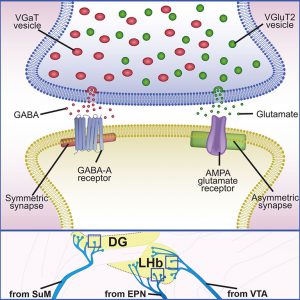
A figure from this study.
Featured Paper of the Month – Novermber 2018.
Root and Zhang et al. (from Dr. Morales’ lab) identified throughout the brain concentrated populations of glutamate and GABA co-transmitting neurons in ventral tegmental area, entopeduncular, and supramammillary nuclei. Single axon terminals from these neurons form a common synaptic architecture that co-transmit glutamate and GABA from distinct synaptic vesicles at independent asymmetric or symmetric synapses.
Publication Information
Selective Brain Distribution and Distinctive Synaptic Architecture of Dual Glutamatergic-GABAergic Neurons. Journal Article
In: Cell Rep, vol. 23, no. 12, pp. 3465–3479, 2018, ISSN: 2211-1247 (Electronic).
